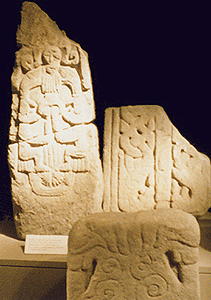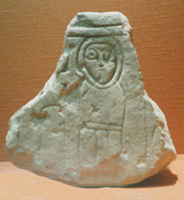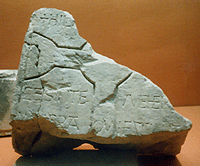
EBK Home
Kingdoms
Royalty
Saints
Pedigrees
Archaeology
King Arthur
Adversaries
For Kids
Mail David
 York Minster, York
York Minster, YorkSite of King Edwin's Palace
The Cathedral & Metropolitcal Church of St. Peter in York is popularly known as 'York Minster' from its original foundation as a missionary church or monaterium. It is the seat of the Archbishop of York and, as such, is, not surprisingly, the most dramatic of churches in Northern England. It is simply vast - the largest medieval cathedral in Northern Europe - and displays some of the best examples of the medieval craftsman's work to be found anywhere. Particularly of note are the fine carvings in the chapter house (c.1275) and the fantastic array of medieval glass dating back to the 12th century.
The present structure
was built in several stages between the early 13th and late 15th
centuries. The transepts are early English, the nave is decorated gothic
and the tower, quire & lady chapel are Perpendicular. Remains of the
previous Norman structure can be seen in the undercroft, but the Minster
has been the site of Christian worship since King Edwin
of Northumbria was baptised here by St.
Paulinus in AD 627. Traditionally this was in the well still to be
seen in the present cathedral crypt. It stood just to the north of the old
Roman Military Headquarters Building which is thought to have become the
Palace of the Deiran and then the Northumbrian Kings. The threshold of a
late 4th century entrance, excavated at the back of the great basilica,
certainly became considerably warn over a long period of time - probably
well into the 7th century. While the grand main entrance to the courtyard
still survives today as Minster Gates.
"A new structure of a wondrous
basilica was in the days of this bishop began, completed, and consecrated.
This house of appropriate altitude is supported by solid columns set under
curved arches. Within it sparkles with admirable ceilings and windows, and
in its beauty shines, environed with many aisles (or apsidal chapels). It
has a great number of apartments with distinct roofs, which contain thirty
altars with various ornaments. Two disciples, Enbald and Alcuin, at the
command of the prelate erected this temple, and he himself consecrated it
to the Saviour ten days before his death." Another associated building of note was a
small bellcote with two large bells. The trappings within were described
thus: "The bishop had constructed a large
altar and covered it all about with gold and silver and jewels. He
dedicated it to the name of holy Paul; He suspended above this altar a
lofty candelabrum, which sustained three large vessels for oil with nine
rows of lights. He raised the banner of the cross aloft the altar, and
covered the whole with precious metals.... And he made another altar, and
clothed it with pure silver and with precious stones, and dedicated it to
the martyrs and to the cross." The high number of chapels can probably be
explained by the use of multi-storied galleries. Bishop Albert crowned
King Erdwulf of Northumbria in one of these dedicated to St. Paul in AD
796. The cathedral's school and library were the envy of all Europe at
this time. However, when the Vikings took York in AD 866, the buildings
were sacked and the library dispersed, if not destroyed. The cathedral was
in decline. Later, however, constitutional changes forced upon the
complex, and instigated by Bishop Wulfstan
II, led Bishop Aeldred
to undertaking considerable new building work. Important Burials in the Saxon Cathedral
include: King Edwin's Head (AD 632), King Aelfwin (AD 678), Archbishop
Egbert (AD 766), King Edbert (AD 768), Archbishop Enbald
I (AD 796), King
Osbald (AD 799), King Guthfrith (AD 895), King Sweyn (temporarily in AD
1014) and Archbishop Aeldred (1069). It survived until
1069 when it was destroyed by the ravaging Vikings. The pagan King Edwin was married to Princess Ethelburga
of Kent who had brought Paulinus to the north as her personal chaplain. At
the Royal palace in York, Edwin allowed him to build a church "of weed, of
hasty workmanship, whilst he was receiving instruction, in preparation for
baptism." We know that it stood within an 'arx' (walled
enclosure) and was reached from the 'aula' (the Royal Palace) by
crossing a public square. Soon after his conversion, however, the King set about
encasing this temporary shack within a basilican cathedral of stone. Unfortunately, the city was overrun by Welsh and Mercian troops six years
later and the scaffolded church was set alight. Edwin was killed in battle
soon afterward and his cathedral remained a sad ruin for at least a year.
Upon King Oswald's accession,
however, building work recommenced and York Minster was finally completed
and dedicated to St. Peter in AD 640. It was a fine building, though the
windows were apparently unglazed, being instead covered with translucent
linen or boards pierced with holes. Oswald had his uncle Edwin's body was
buried at Whitby Abbey, but his head,
which had become detached in battle, was taken to the chapel of St.
Gregory at the new minster in York. Here, it was venerated as a holy relic
for many centuries. The large Saxon cemetery excavated beneath the
present south transept may also have been founded near the church at this
time.
The pagan King Edwin was married to Princess Ethelburga
of Kent who had brought Paulinus to the north as her personal chaplain. At
the Royal palace in York, Edwin allowed him to build a church "of weed, of
hasty workmanship, whilst he was receiving instruction, in preparation for
baptism." We know that it stood within an 'arx' (walled
enclosure) and was reached from the 'aula' (the Royal Palace) by
crossing a public square. Soon after his conversion, however, the King set about
encasing this temporary shack within a basilican cathedral of stone. Unfortunately, the city was overrun by Welsh and Mercian troops six years
later and the scaffolded church was set alight. Edwin was killed in battle
soon afterward and his cathedral remained a sad ruin for at least a year.
Upon King Oswald's accession,
however, building work recommenced and York Minster was finally completed
and dedicated to St. Peter in AD 640. It was a fine building, though the
windows were apparently unglazed, being instead covered with translucent
linen or boards pierced with holes. Oswald had his uncle Edwin's body was
buried at Whitby Abbey, but his head,
which had become detached in battle, was taken to the chapel of St.
Gregory at the new minster in York. Here, it was venerated as a holy relic
for many centuries. The large Saxon cemetery excavated beneath the
present south transept may also have been founded near the church at this
time. Despite its new found pilgrimage potential
however, the church at York lost its cathedral status to Lindisfarne in
Northumberland the following year. Thirty years of obscurity followed,
until St. Wilfrid persuaded the
Northumbrians to switch from Irish-based to Roman Catholicism. Being
highly influenced by Rome itself, which he had visited, Wilfred preferred
the urban setting of York to rural Lindisfarne. Upon becoming Bishop of
York in AD 664, he found the minster in a state of disrepair: "The
leaking roofs admitted rain and the open windows, birds who built their
nests within and were constantly flying in and out. The rain and the
birds, together, defiled and discoloured the neglected walls."
But he did not repair the structure as his new cathedral with whitewashed
walls of lime until his return from a European tour in AD 669. He had the
roof releaded and glazed the windows for the first time. It may have been
at this time that the little used Royal palace surrounding the cathedral
was handed over to Episcopal control, while the Kings of Northumbria built
a new residence around the the south-east gate of the old Roman fort. This
area is now called 'King's Square'
although the name may only date from the Viking period.
Despite its new found pilgrimage potential
however, the church at York lost its cathedral status to Lindisfarne in
Northumberland the following year. Thirty years of obscurity followed,
until St. Wilfrid persuaded the
Northumbrians to switch from Irish-based to Roman Catholicism. Being
highly influenced by Rome itself, which he had visited, Wilfred preferred
the urban setting of York to rural Lindisfarne. Upon becoming Bishop of
York in AD 664, he found the minster in a state of disrepair: "The
leaking roofs admitted rain and the open windows, birds who built their
nests within and were constantly flying in and out. The rain and the
birds, together, defiled and discoloured the neglected walls."
But he did not repair the structure as his new cathedral with whitewashed
walls of lime until his return from a European tour in AD 669. He had the
roof releaded and glazed the windows for the first time. It may have been
at this time that the little used Royal palace surrounding the cathedral
was handed over to Episcopal control, while the Kings of Northumbria built
a new residence around the the south-east gate of the old Roman fort. This
area is now called 'King's Square'
although the name may only date from the Viking period. For almost the next hundred years, the
cathedral and the diocese flourished, culminating in Bishop Egbert
being raised to the Archiepiscopate in AD 735. Bishop Wilfred
II had refurbished the cathedral in the AD 720s; but, on 23rd April AD 741, the
church, or at least part of the Archiepiscopal complex, was apparently
destroyed by fire. It must have been pretty devastating, for the place was
apparently not rebuilt until Bishop Albert
came to the Archiepiscopal throne in AD 767. Though it is just possible
the description is of Holy Trinity Priory in Micklegate, the cathedral's famous
schoolmaster, Alcuin, appears to describe this building in his poetry:
For almost the next hundred years, the
cathedral and the diocese flourished, culminating in Bishop Egbert
being raised to the Archiepiscopate in AD 735. Bishop Wilfred
II had refurbished the cathedral in the AD 720s; but, on 23rd April AD 741, the
church, or at least part of the Archiepiscopal complex, was apparently
destroyed by fire. It must have been pretty devastating, for the place was
apparently not rebuilt until Bishop Albert
came to the Archiepiscopal throne in AD 767. Though it is just possible
the description is of Holy Trinity Priory in Micklegate, the cathedral's famous
schoolmaster, Alcuin, appears to describe this building in his poetry:
